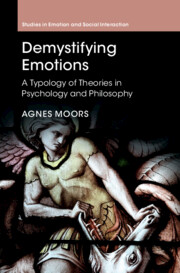Book contents
- Demystifying Emotions
- Studies in Emotion and Social Interaction
- Demystifying Emotions
- Copyright page
- Contents
- Figures
- Tables
- Boxes
- Preface
- Acknowledgment
- Abbreviations
- Part I Introduction
- Part II Emotion Theories One by One
- Part III Conclusion
- Chapter 10 Conclusion
- References
- Index
- Titles Published in the Second Series (continued from page ii)
Chapter 10 - Conclusion
from Part III - Conclusion
Published online by Cambridge University Press: 11 August 2022
- Demystifying Emotions
- Studies in Emotion and Social Interaction
- Demystifying Emotions
- Copyright page
- Contents
- Figures
- Tables
- Boxes
- Preface
- Acknowledgment
- Abbreviations
- Part I Introduction
- Part II Emotion Theories One by One
- Part III Conclusion
- Chapter 10 Conclusion
- References
- Index
- Titles Published in the Second Series (continued from page ii)
Summary
This concluding chapter summarizes the main insights gained in this book. Emotion theories show substantial agreement in their working definition of emotions in terms of the typical and apparent properties of emotions (intensional format) and the prototypical emotions (divisio format) they want to see explained. Their constitutive explanations range from narrow to broad. The most pronounced differences reside in the causal-mechanistic explanations they propose. Five fault lines stand out centering on the questions whether (a) emotions are caused by a stimulus-driven or goal-directed process, (b) the origin of feelings is central or peripheral, (c) emotions are caused by special-purpose or general-purpose mechanisms, (d) emotions do or do not form a scientific set, and (e) the variety in the set of emotions is best captured with discrete emotions or dimensions. The chapter also examines whether there is any hope for a unifying theory integrating several theories or a general framework for conducting emotion research. Starting from a unifying theory that combines a maximum of mechanisms, a pruning stage is required based on empirical research. A speculation about the result of this pruning exercise, inspired by the goal-directed theory advocated in this book, is presented, ultimately leading to the demystification of emotion.
Keywords
- Type
- Chapter
- Information
- Demystifying EmotionsA Typology of Theories in Psychology and Philosophy, pp. 293 - 301Publisher: Cambridge University PressPrint publication year: 2022

